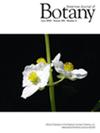Striking genetic homogeneity in the widespread South American bracken
Abstract
Premise
Bracken (Pteridium, Dennstaedtiaceae) is a cosmopolitan genus of aggressive disturbance colonizers that are toxic to agricultural livestock. The taxonomy of Pteridium has been treated in multiple schemes, ranging from one to six species worldwide, with numerous subspecies and varieties. Recent work has focused on the worldwide distribution and systematics of the bracken fern, but South America has been poorly represented. We present the first continent-wide sampling and analysis of Pteridium esculentum, a Southern Hemisphere diploid species.
Methods
Within South America, P. esculentum has several morphotypes, distinguished into subspecies by variation in indument and lamina architecture. We used double digest restriction site-associated DNA sequencing (ddRADSeq) to assess the phylogenetic relationships of P. esculentum subspecies.
Results
We found a striking genetic homogeneity in the species, being able to support only two morphotypes from molecular data: P. e. arachnoideum and P. e. campestre. We had high confidence for shallow and deep phylogenetic relationships, but less support for relationships among crown groups.
Conclusions
We describe an east-west geographic pattern that would explain the relationships between populations; and, in contrast to previous studies, we detected differences with P. esculentum from Australia. These results will lay the foundations for studying variations in this species' behavior as a weed, as well as its impact on the production of agricultural livestock in South America.


 求助内容:
求助内容: 应助结果提醒方式:
应助结果提醒方式:


